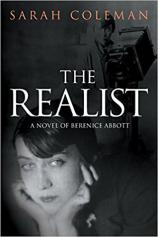The Realist: A Novel of Berenice Abbott
Review
The Realist: A Novel of Berenice Abbott
Sarah Coleman’s THE REALIST is a novel about the life and work of Berenice Abbott, a strong-headed and talented photographer.
The book opens as Berenice is giving a speech at the first National Conference on Photography in 1951. We are introduced to important players in her professional life, including the men who will be her roadblocks and individuals who will inspire her. In her speech, she insists that the talents of women photographers are overlooked. The female artists are disadvantaged due to the sexism of camera companies, curators, editors and publishers. Coleman is able to perfectly capture the interiority of this moment; Berenice is an accomplished photographer, “but right now she might as well be her ten-year-old self: awkward, plain Bernice.”
The book is divided into parts, anchored by their location and year. The opening of each part features a photograph of Abbott’s, which gives readers insight into the work being discussed in the novel. We can immediately see the tension in Bernice’s relationship with her mother, especially after her stepfather attempts to rape her. Instead of looking up to her mother, Bernice finds inspiration in other female role models, such as Nelly Bly. She writes an essay about heroes: “Like Miss Bly, I will seek experiences and challenge the limitation of my sex.” These details foreshadow how Abbott will live. Coleman writes with a careful attention to how Bernice reacts to the art she sees in everyday life, even as a child.
"THE REALIST will enchant readers, who will long to know more about Berenice Abbott and the dynamic people she encounters."
At Ohio State University in 1918, Bernice meets Lilian Watkins, an actress who will change her life. Bernice moves to New York with Lil and her boyfriend, where they are engulfed by a world of art and eccentricity. She dabbles in a variety of arts, primarily sculpting. She understands her appreciation of art in the everyday --- “shop signs, salt shakers” --- and begins to appreciate photography after she models for Man Ray. The artists she meets are written as rich and exciting characters, so much so that readers almost forget they are real people.
Repressed sexuality is an important theme throughout the novel. Bernice has an unwavering attraction to Lil. She kisses her one evening as they are running lines before a play, and both come down with the Spanish flu. Bernice lives, but Lil does not. There is intense guilt and the shame surrounding her sexuality. Lil’s death leads to Bernice moving to Paris, where she becomes Man Ray’s assistant and ultimately finds success on her own as a photographer. It is also here where she meets Tylia, a lover who will christen Bernice under her new name, Berenice. This subtle change signifies a turning point in her life.
Berenice finds success in Paris as she takes portraits for high-profile clients like Peggy Guggenheim. Man Ray cannot handle her success. Berenice quits and decides to return to New York.
New York provides a second wave of artistic inspiration for Berenice, but she struggles financially in the midst of the Depression. Still, she continues a project that will move her for the next several years: Changing New York. The passion that moves her is obvious. Berenice falls in love --- twice --- with a man named Rod and a writer named Liz, who is her partner until Liz’s death. She experiences discrimination both for her sexuality and her gender. She takes photos for magazines and has her first show overshadowed by Salvador Dali. Alfred Stieglitz’s “Spiritual America,” an image of a castrated horse, haunts her throughout her career almost as much as Stieglitz himself.
The novel ends with Berenice taking her first flight to a conference in Aspen. Its closing does not do justice to the 50 pages before it, which are filled with large, powerful moments in which Berenice comes to terms with her sexuality, her mother, and the triumphs and failures of her career. The novel concludes as the plane takes off, implying that Berenice will also soar. It is a wrap-up that feels too tidy for a book that is so true to the complexities of life. The opening chapter, however, is more satisfying for readers after understanding the frustration Berenice has experienced in her career.
THE REALIST will enchant readers, who will long to know more about Berenice Abbott and the dynamic people she encounters. Historical fiction enthusiasts and devout feminists will be engaged with Coleman’s strong relationship to this unapologetic woman from the first page to the last.
Reviewed by Kate-Lynn Brown on April 20, 2018
The Realist: A Novel of Berenice Abbott
- Publication Date: December 5, 2017
- Genres: Fiction, Historical Fiction
- Paperback: 354 pages
- Publisher: Silverwood Books
- ISBN-10: 1781327297
- ISBN-13: 9781781327296




